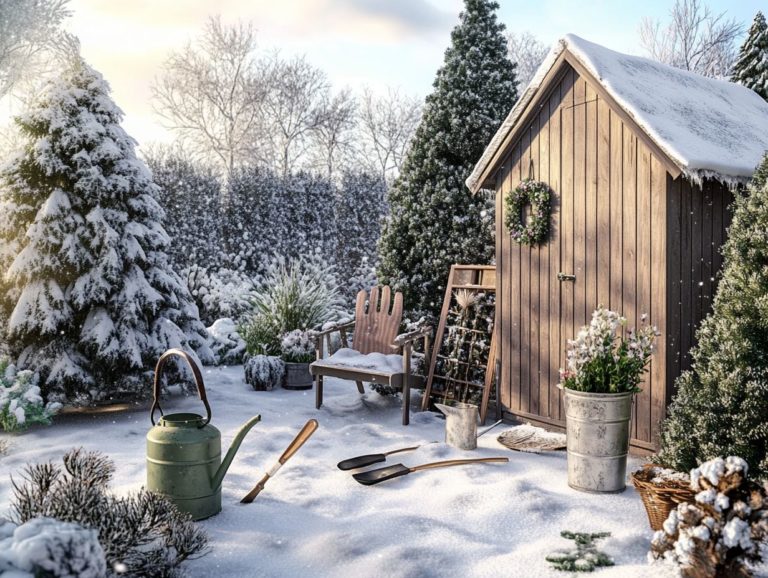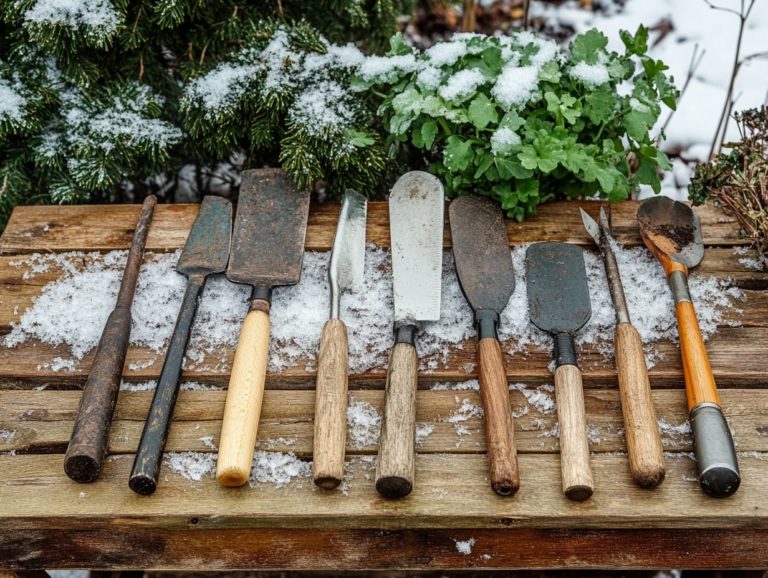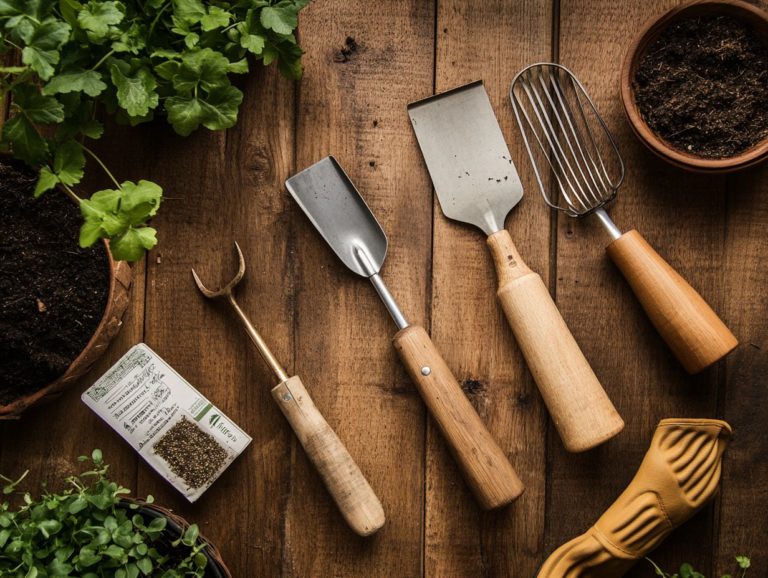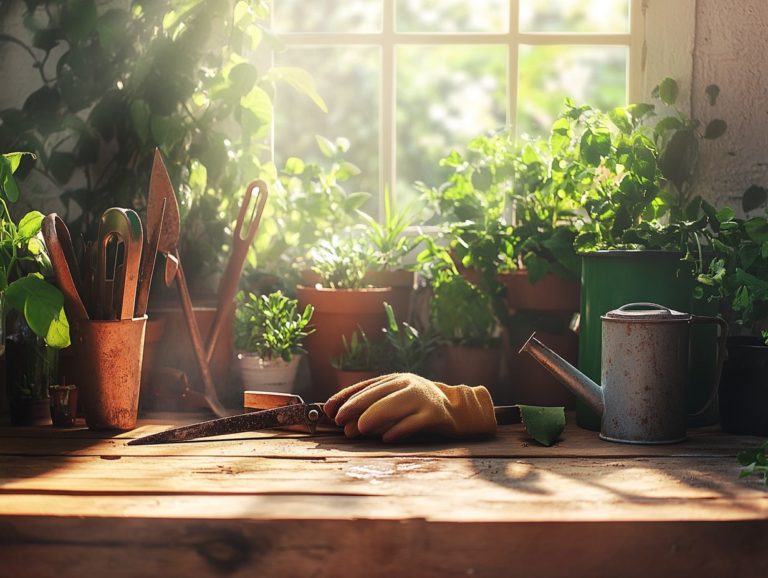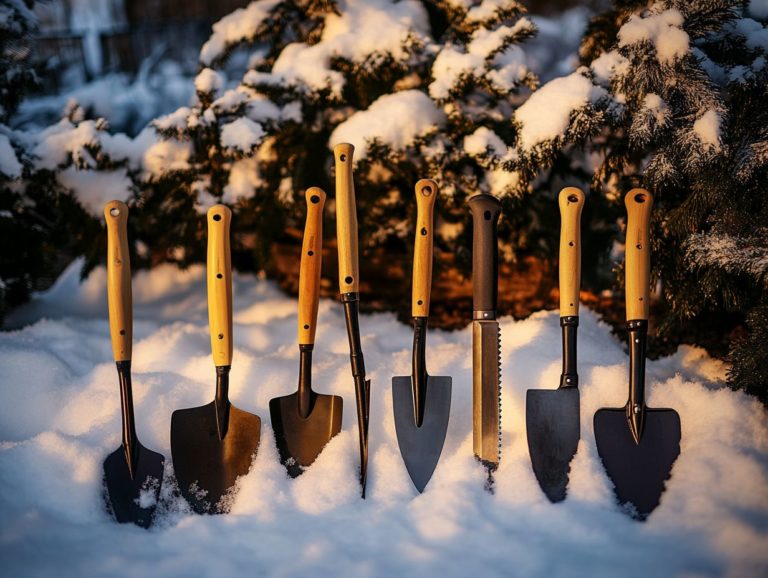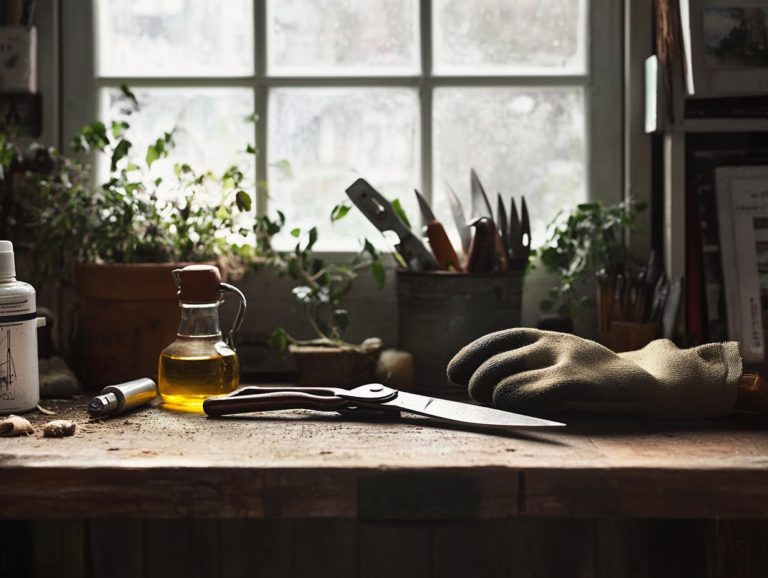Choosing the Right Planting Tools for Winter
Winter planting can be both a rewarding and challenging experience for you as a gardener.
Equipped with the right tools, you can successfully nurture plants even during the colder months. Knowing which tools to choose is crucial.
This article delves into the essential planting tools for winter, highlighting factors to consider when making your selections and offering top recommendations based on reviews.
You’ll learn how to maintain and store your tools to ensure they stand the test of time across many seasons. Get ready to transform your winter gardening like never before!
Contents
- Key Takeaways:
- Essential Planting Tools for Winter
- Factors to Consider when Choosing Planting Tools
- Top Planting Tools for Winter
- Tips for Maintaining and Storing Planting Tools
- Frequently Asked Questions
- What are some important factors to consider when choosing planting tools for winter?
- Are there specific tools designed for winter planting?
- Can I use the same tools for winter planting as I do for other seasons?
- What are some recommended planting tools for winter?
- Can I use power tools for winter planting?
- How can I protect my planting tools from damage during the winter?
Key Takeaways:
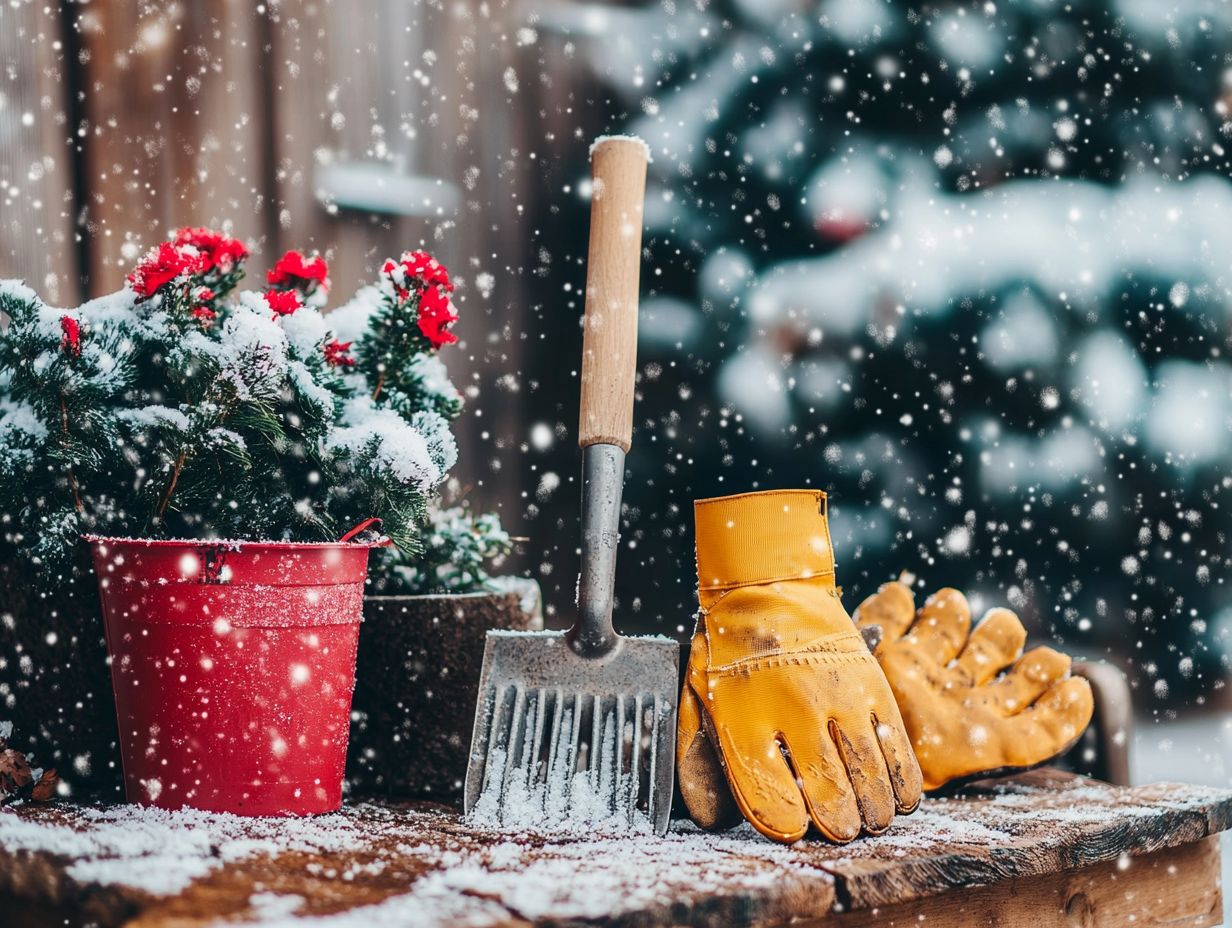
- Choose tools that match your climate and soil conditions for successful winter gardening.
- Think about the types of plants you’ll grow before buying tools.
- Maintain and store planting tools properly to prolong their lifespan and make gardening easier.
Benefits and Challenges of Winter Planting
Winter planting offers unique benefits and challenges. With the right approach, you can grow plants that can survive the cold while enjoying a quieter time for reflection.
The advantages of winter planting are certainly noteworthy. Improved soil health and reduced pest activity are vital for nurturing a thriving garden. Experts like Caroline Bloomfield and Tonya Barnett highlight how winter crops can naturally boost nutrient levels in the soil, setting a rich foundation for your future plants.
However, it’s crucial to remain vigilant about potential hurdles, such as unexpected frost and restricted growing conditions during these colder months. By adopting effective protective measures and understanding the nuances of your local climate, you can significantly improve how you navigate this challenging yet rewarding facet of cultivation.
Essential Planting Tools for Winter
To successfully navigate the challenges of winter planting, it’s essential to have a selection of premium gardening tools designed to endure colder temperatures and tougher soil conditions, along with knowing how to choose the right soil for winter gardening.
Don’t let winter slow you down! Equip yourself with the right tools now to stay ahead. Invest in must-have tools like a high-quality wheelbarrow, sharp garden shears, and durable hand trowels to make your planting experience manageable and efficient.
Sturdy gloves are also important; they will protect your hands from the elements and provide comfort as you tackle your winter gardening tasks.
Types of Tools Needed
When you’re gearing up for winter planting, having the right tools at your disposal is key to executing your gardening tasks with efficiency and flair. Gather basic garden essentials like wheelbarrows, garden shears, and hand trowels, along with specialized tools such as special gardening knives called hori hori knives and garden rakes. These instruments are critical for everything from planting seeds to maintaining your garden.
Choosing reliable soil preparation tools, including shovels and cultivators, is fundamental to creating the perfect environment for your winter crops. If irrigation is on your agenda, don’t overlook the importance of drip hoses and watering cans; they’re crucial for keeping the soil consistently moist.
Your toolkit shouldn’t stop there. Equip yourself with protective gear like frost blankets and garden cloches to shield those tender seedlings from the harsh winter chill. By organizing your tools based on their specific functions, you’ll elevate your gardening experience and maximize the growth potential of your winter plants, setting the stage for a bountiful harvest.
Factors to Consider when Choosing Planting Tools
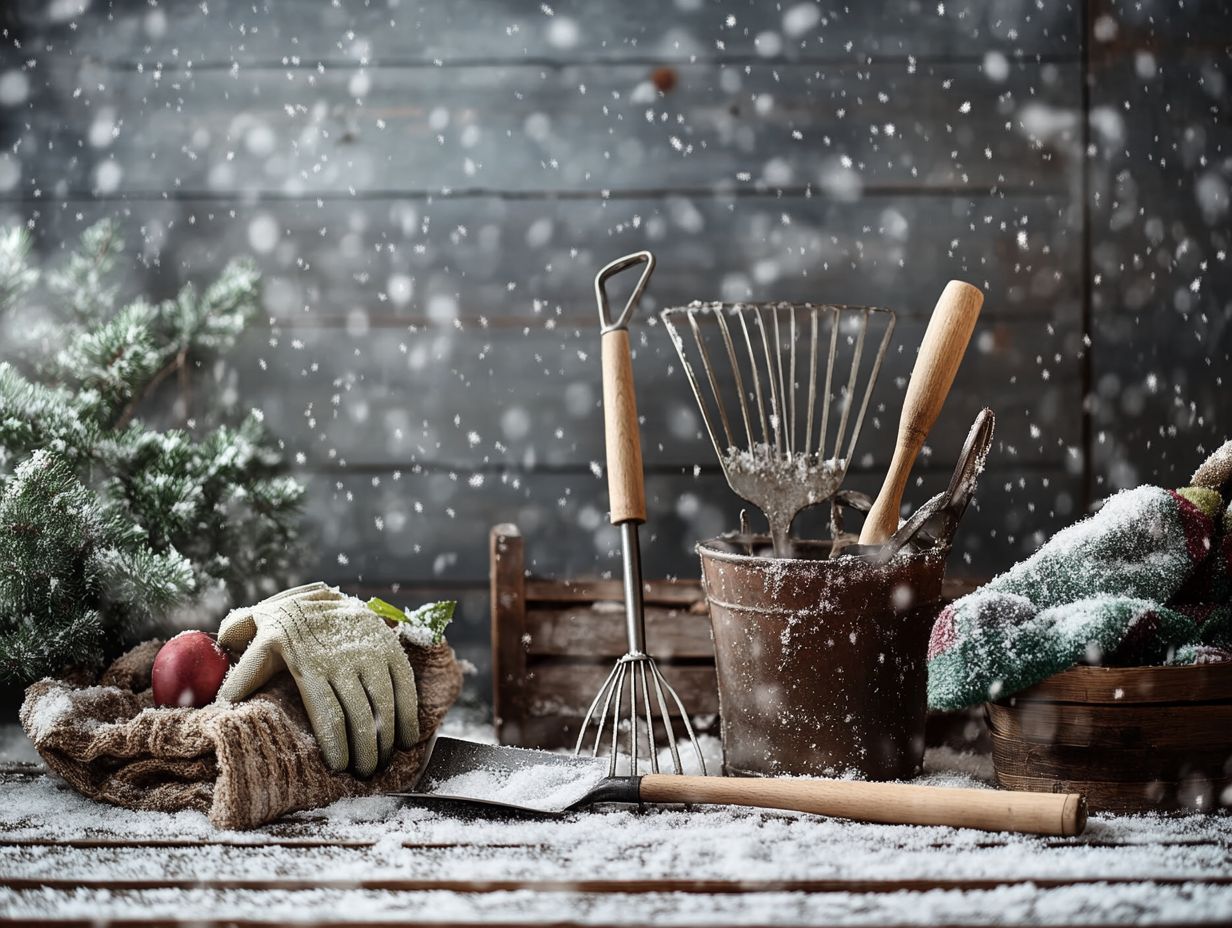
When selecting garden tools for winter planting, consider several factors, such as climate and soil conditions. Using the right essential tools for winter gardening success can significantly influence your gardening success.
Opting for high-quality tools specifically designed for harsh winter environments will enhance your efficiency. Using these essential tools for winter crop rotation allows you to tackle the challenges of the season while ensuring optimal growth for your plants.
Climate and Soil Conditions
Understanding climate and soil conditions is vital for your winter planting success. These factors greatly influence plant growth and the overall health of your garden.
Take the time to observe your local climate paying attention to temperature extremes and rainfall patterns to make informed choices about which plants will thrive in your environment. A thorough assessment of soil health involves checking its pH (how acidic or alkaline the soil is), nutrient levels, and moisture retention.
By adapting your gardening practices based on these evaluations, you can optimize growth. For instance, adding compost or mulch can enhance soil structure and nutrient content.
Selecting cold-tolerant varieties ensures your plants are equipped to withstand harsh winter conditions. By aligning your planting strategies with a solid understanding of both climate and soil health, you can cultivate a vibrant and resilient garden that flourishes even in the cold months.
Types of Plants to be Planted
When looking into winter gardening, carefully select the right types of plants that can flourish in colder temperatures. Think of winter vegetables and cold-hardy plants.
Cold-hardy vegetables like kale, Brussels sprouts, and root crops such as carrots and turnips are perfect choices for those aiming to cultivate a prosperous garden during the chillier months. Leafy greens like spinach and Swiss chard are resilient enough to withstand frost, ensuring you have fresh produce available even as temperatures dip.
It s essential to prepare your soil right for the best results! Time your planting to coincide with the first frost date in your area. This way, your seeds will have ample opportunity to germinate and thrive before the harsh weather rolls in.
Choose the right varieties now, and watch your winter garden thrive like never before!
Top Planting Tools for Winter
Identifying the finest planting tools for winter is essential for achieving success in your gardening pursuits. Utilizing essential tools for winter garden prep can remarkably enhance both your efficiency and effectiveness.
By selecting top 10 must-have tools for winter gardening that come highly recommended and well-reviewed by experts, you alleviate the challenges that winter planting often presents.
Reviews and Recommendations
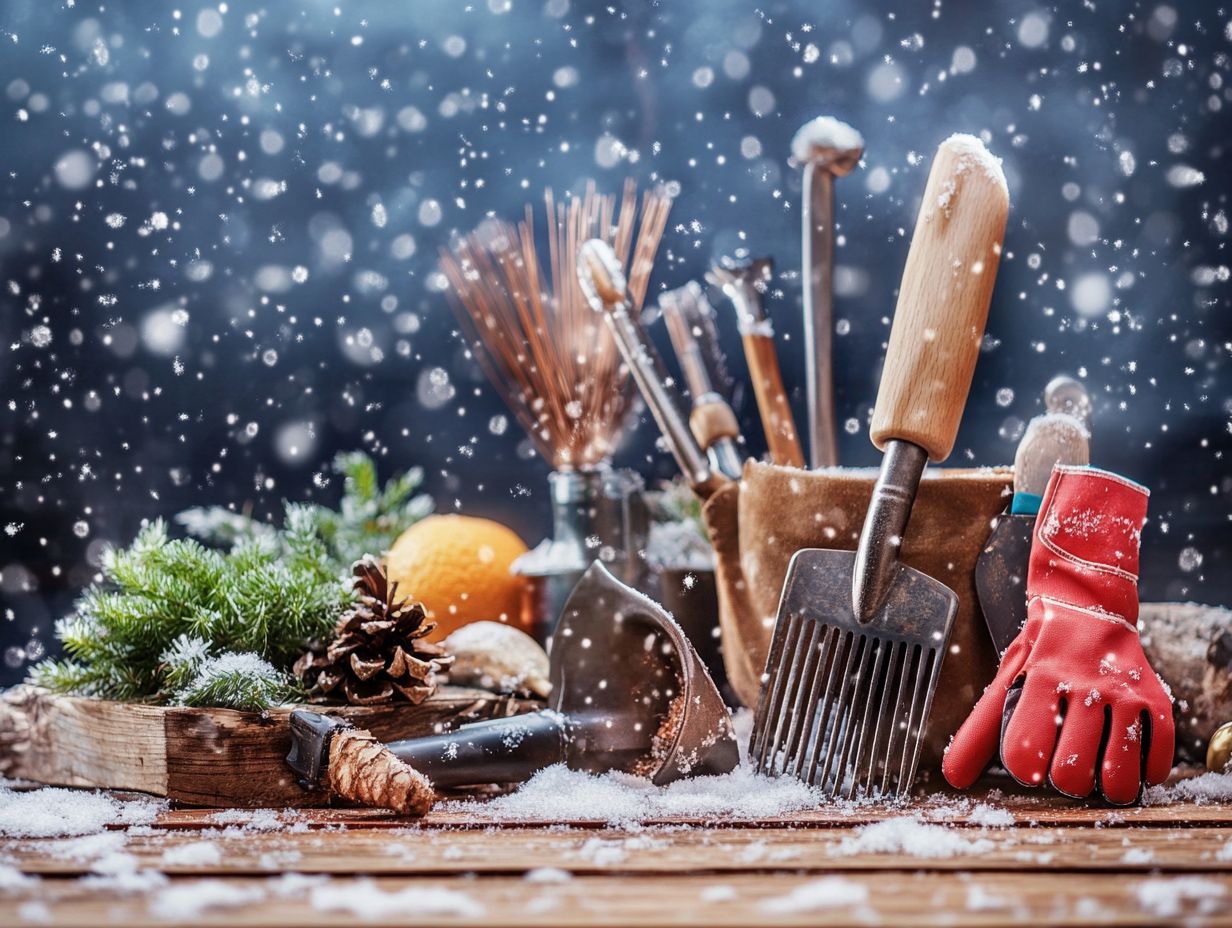
When you’re on the hunt for the best tools for winter planting, consider weighing reviews and recommendations from seasoned gardeners. For a comprehensive guide, check out how to create a winter gardening toolkit. These insights will enable you to make informed choices that enhance your gardening endeavors during the chillier months.
Leverage expert opinions to pinpoint which tools excel in durability and efficiency when faced with the rigors of winter conditions. Many experienced gardeners stress the importance of investing in products that not only endure frost and snow but also improve air in the soil and encourage healthy root development.
Tools for amending the soil and efficient thermal covers often grace the top of the list, providing extra protection and value for your investment. Embracing these recommendations not only cultivates a flourishing winter garden but also enriches your appreciation for the art of gardening itself.
Tips for Maintaining and Storing Planting Tools
Maintaining and storing your planting tools properly is crucial for preserving their longevity and effectiveness. This ensures they remain in peak condition for winter use.
Effective cleaning and storage techniques extend the lifespan of your tools and improve your overall gardening experience.
Proper Cleaning and Storage Techniques
Proper cleaning and storage techniques are essential for maintaining your gardening tools. They help prevent rust and extend usability. Cleaning your tools after each use and storing them in a dry, organized space significantly enhances their performance throughout your gardening journey.
Taking a few simple steps will ensure your tools remain in prime condition:
- Start by rinsing off dirt and debris with water immediately after use to prevent buildup. Ensure you have a reliable water source available.
- Next, scrub away stubborn residues with a brush, especially on blades and prongs, including garden shears and pruning shears. This keeps them sharp and effective.
- After cleaning, drying the tools completely is crucial to avoid moisture that can lead to rust. This is especially important for quality gardening tools like a hand trowel and shovel.
- Store them in a well-ventilated area ideally hung on a wall or in a dedicated toolbox so they stay organized and easily accessible for your next gardening adventure, using must-have tools like a garden rake and hori hori knife.
Final Thoughts and Recommendations
Choosing the right gardening tools will transform your winter planting into an exciting adventure! By following essential gardening tips and choosing the right tools for winter gardening, you can navigate the unique challenges of winter planting and embark on a successful gardening journey.
Adequate soil preparation is crucial. Choose hardy plant varieties and plant seeds that thrive in cooler temperatures. Consider protective measures like row covers or mulch, along with gardening gloves to shield your plants from frost.
Regularly checking and cleaning your basic garden tools extends their lifespan and ensures they perform efficiently when you need them most. Stay updated on seasonal weather patterns to make timely decisions regarding garden maintenance and care.
By prioritizing these strategies and utilizing practical garden tools, you’ll cultivate a more fruitful garden and enjoy a truly rewarding winter gardening experience.
Frequently Asked Questions

What are some important factors to consider when choosing planting tools for winter?
Consider the type of soil, the plants being planted, and the local climate and weather conditions during winter.
Are there specific tools designed for winter planting?
Yes, specific tools for winter planting include cold frames (structures that protect plants from cold weather), row covers, and insulated gloves.
Can I use the same tools for winter planting as I do for other seasons?
It’s best to have a separate set of tools specifically for winter planting. Cold and wet conditions can damage or rust regular gardening tools.
What are some recommended planting tools for winter?
Recommended tools for winter planting include a hand trowel, a spade, a shovel, and a gardening fork. Additionally, consider using essential gardening tools for cold climates like a watering can or hose with a spray attachment, which is also helpful for watering plants in freezing temperatures.
Can I use power tools for winter planting?
Power tools can be used for winter planting, but ensure they are designed for cold and wet conditions. Always follow safety precautions when using power tools in any season.
Share your own tips or experiences with winter gardening to foster a community of avid gardeners!
How can I protect my planting tools from damage during the winter?
Protecting your tools in winter is crucial. Clean and dry them after each use.
Store them in a dry, sheltered spot. A wheelbarrow can be handy for transportation.
Oiling the metal parts is essential to prevent rust. This is especially important for tools like the garden fork and trowel.
By taking these steps, you’ll ensure your tools stay in top shape for the next planting season!

